Understanding Maladaptive Daydreaming: The Ultimate Guide

We always have that urge to daydream most of the time. This is actually a medical condition known as maladaptive daydreaming. Experts have often thought that a maladaptive daydreaming condition is a form of dissociation. This belief went on for a while until this condition drew the attention of the medical fraternity. Thanks to its unique set of symptoms, health professionals can effectively single it out from other similar mental disorders.
At this moment, you might be having questions lingering in your mind. Some of the questions include:
- Is maladaptive daydreaming part of a mental illness?
- What exactly is maladaptive daydreaming?
- How can you manage it?
In this article, we are going to uncover everything you need to know about maladaptive daydreaming, its symptoms, and possible remedies.
Proper treatment from mental health experts can save you from maladaptive daydreaming. Click the button below to book your appointment.
What Is Maladaptive Daydreaming?
Daydreaming is part of every human’s life. It is also perfectly normal for everyone to daydream. Daydreaming can also boost your creativity and this is also a healthy way of living. More often, people daydream about getting relieved of their tiring and monotonous daily routines. Studies show that about 47% of human beings undergo daydreaming while awake. This also is perfectly normal and there should be nothing to worry about. However, if your daydreaming goes beyond the normal bounds or becomes uncontrollable, it may interfere with your life. Excessive daydreaming can negatively impact your functional capabilities. At this point, your daydreaming may turn to maladaptive daydreaming. Maladaptive daydreaming describes a state where you get occupied with daydreaming ideas or thoughts.
While in this state, you are completely cut off from reality. As a matter of fact, you became unaware of your surroundings and the time you spent while in that state of daydreaming. Sometimes your state of daydreaming can take a toll on you to the extent of not being in control of yourself. This is where maladaptive daydreaming mental health condition comes in. Maladaptive daydreaming is sometimes referred to as a daydreaming disorder. This is a condition that makes you experience daydreams frequently. You may not even detach yourself from these daydreams. In extreme cases, daydreaming can become too distracting to the point of interfering with your normal daily lifestyle. So, what exactly triggers maladaptive daydreaming?
What Triggers Maladaptive Daydreaming?
Below are some of the known activities that can cause maladaptive daydreaming:
- A lot of noise
- Real-life events
- Conversations
- Certain smell
- Relatable movies
- Sensitive topics
Once you get indulged in maladaptive daydreaming and thoughts, you may not be able to judge or take control of your behavior and actions. Daydreaming may also become intense even in front of other people.
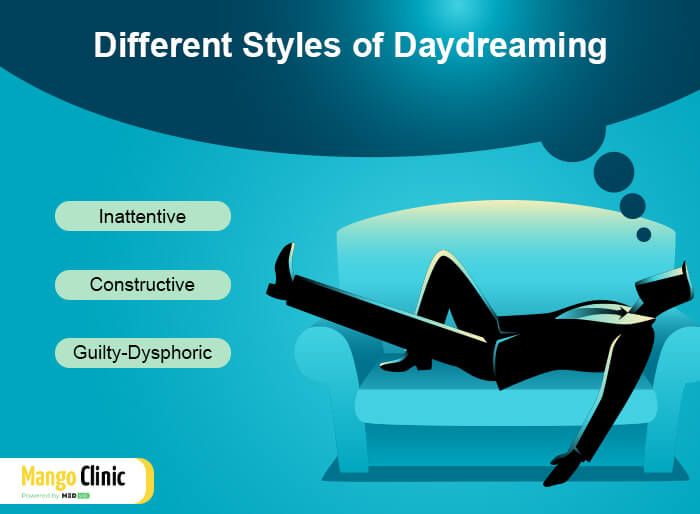
For instance, some individuals might find themselves in a maladaptive daydreaming state due to cases of trauma and fantasy. These two instances can become their daily coping mechanism that can ultimately affect their normal life.
Is Maladaptive Daydreaming a Mental Illness?
Although maladaptive daydreaming is not yet considered a separate medical diagnosis and has not yet taken place in the Diagnostic and Statistical Manual of Mental Disorders (DSM-5), the condition is widely emphasized.
Maladaptive Daydreaming Symptoms
Here are signs and symptoms of maladaptive daydreaming you should look out for:
- Intense daydreams
- Inability to meet deadlines
- Failure to complete tasks on time
- Failure to focus on your daily life routine
- A strong desire to keep daydreaming
- Prolonged cases of daydreaming
- Showing facial expression even in your unconscious state
- Difficulties in falling asleep (insomnia)
- Fidgeting or repetitive body movements
- Talking to yourself
- Real-world events or sensory stimuli trigger daydreams
- Escaping reality
- Ignoring the real events happening around you for long durations
- Vivid daydreams that can exhibit characters, settings, and plots
Contact us to help you with vivid daydreams. Click the button below to book your appointment.
Main Differences between the Normal Daydreaming and Maladaptive Daydreaming
| Normal Daydreaming | Maladaptive Daydreaming |
| In most cases, your mind will just be wandering | Your mind indulges in unrealistic and false realities |
| You intend to take a break from reality | You intend to escape from real facts and immerse into other realities |
| The intention is to plan and even brainstorm ideas regarding certain tasks | You tend to waste precious time on meaningless thoughts and ideas, making you unable to complete some tasks |
| It’s never a source of pleasure. Daydreamers are usually satisfied with their real-life | This is usually the only way to achieve some pleasure by living in an alternative reality |
| Daydreaming happens when sitting or lying without involving repetitive movements | Continuous repetitive movements accompanied by eccentric face gestures, pacing, rocking, or fidgeting |
| Long gaps in between daydreams that can last weeks between relapses | The repetition of your maladaptive daydreaming may become your daily reality with hardly any break |
| Comes with a positive impact on you and the will of indulging in this activity is controllable | It is highly addictive and patients become helpless in avoiding it |
| It is a normal part of your behavior | It is regarded as an abnormal and serious mental issue |
What Are the Causes of Maladaptive Daydreaming?
Experts have not yet established the real reason for the rising cases of maladaptive daydreaming among different people. However, numerous links and connections have helped medical professionals to point out the possible causes of this mental problem. Here are the factors that might help explain the possible cause of the maladaptive daydreaming issue:
Social Anxiety
There are many reasons why you may daydream. But the most common goal of experiencing maladaptive daydreaming is to achieve the ultimate sense of relief. For that reason, you may daydream especially if you have a social anxiety problem. This condition can make you start indulging in maladaptive daydreaming to gain some temporary relief from your anxiety symptoms. Usually, social anxiety makes people isolate themselves from their family members and society in general. The only refuge for such people is indulging in maladaptive daydreaming to find an imaginary comfort zone from reality.
Childhood Traumas
Traumas experienced at the early stages of growth and development can be harrowing even in old age. In this regard, you are likely to get some flashbacks of your past traumatic life incidents in your adulthood. Studies show that childhood traumas may deeply be associated with numerous cases of maladaptive daydreaming. This incident can occur as a way to help you cope with past painful memories. Therefore, research states that maladaptive daydreaming can be perceived as the ultimate coping mechanism that helps overcome childhood traumas. A separate study suggests that cases of maladaptive daydreaming are more prevalent in female survivors of sexual molestation than males. These females may at one time in their young age been subjected to sexual abuse. So their childhood traumas extended into their adulthood.
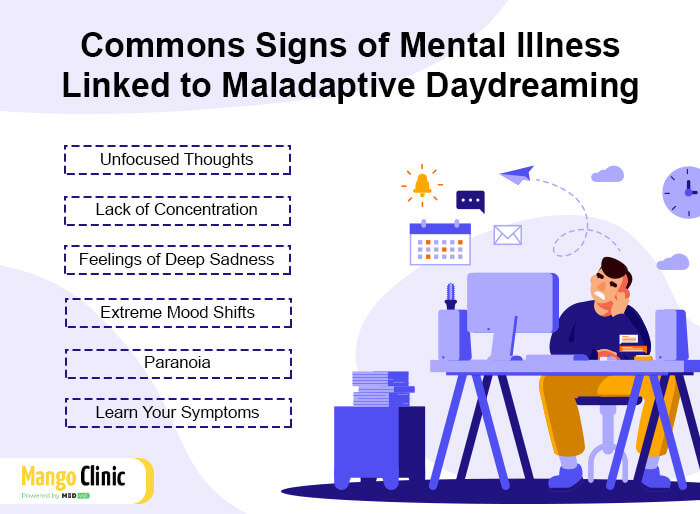
Real-life Problems
Numerous challenges in life have left many people disturbed psychologically. As a result, such individuals find themselves suffering from maladaptive daydreaming. Their real-life relationship problems, domestic issues, financial problems, and several other everyday life issues have plunged them into a state of daydreaming.
Distress Caused by Addiction
According to studies, maladaptive daydreaming can have features similar to those seen among addicts. These typical features can range from addiction to playing video games to substance abuse and many other cases. Most people diagnosed with maladaptive dreaming are likely to suffer from mental breakdown and distress. This is due to the fact that such individuals cannot control this behavior on their own.
Dissociative Tendencies
Dissociative tendencies can be said to be a mental disorder where individuals resort to focusing mainly on their inner thoughts. Most dissociative tendencies are linked to incidents of lapses in attention. In this case, individuals with this problem tend to remain totally inattentive to anything including external stimuli. The problem of dissociative tendencies can lead to maladaptive daydreaming. This is usually the case among those with a history pointing to their past traumatic experience and abuse.
Trying to Overcome Shame
Maladaptive daydreaming is simply a type of coping mechanism to overcome shame. This happens more often when you are dissatisfied with yourself. So, you may end up creating a fantasy world of your own in the hope of overcoming your situation. The real problems come about when you decide to completely replace your fantasy with the real world around you. In this sense, maladaptive daydreaming becomes the only way to help you keep up with your self-worth, comfort, and validation. With time, this complex fantasy can turn into a disability.
The problem of dissociative tendencies can lead to maladaptive daydreaming. Click the banner below to book your appointment.
Maladaptive Daydreaming Vs. ADHD
Contrary to common beliefs, maladaptive daydreaming does not imply that you have some underlying mental problems. However, medical professionals believe that dealing with attention deficit hyperactivity disorder (ADHD) can easily cause maladaptive daydreaming problems. If you can revisit the symptoms and behavior of people struggling with ADHD, you will realize that they procrastinate a lot. Their procrastination is way more than what ordinary people do. Apart from that, people with ADHD indulge more in excessive thinking than those without. It is essential to draw a line separating the difference between procrastination and creative thinking. While people who struggle with ADHD and maladaptive daydreaming find it difficult to control their vivid dreams, those with creative thinking find it easy to control their thoughts and even snap out of them so easily.
ADHD is among the common clinical diagnoses with several signs and symptoms. However, it is not yet clear whether ADHD can develop into maladaptive daydreaming. Alternatively, it is not known if maladaptive daydreaming is one of those primary causes of procrastination and hyperfocus. A combination of ADHD and maladaptive daydreaming can become a disability in your life. This combination can negatively impact your social, professional, academic, and personal life. Individuals with ADHD can easily develop hyperfocus, particularly when daydreaming. They may not respond to a call quickly or give appropriate reactions to different situations. Another thing you need to know about maladaptive daydreaming and ADHD is that the former can become more prominent with time. Those with ADHD can easily get distracted with imagination and thoughts. Studies show that maladaptive daydreaming can have a drastic effect on your daily life. You may become more distressed and depressed than before. Additionally, time-wasting can become a major problem in your life.
Many unexplored factors are linked to maladaptive daydreaming. Experts need to find ways to address them for a better understanding of the existing connection between ADHD and maladaptive daydreaming. Luckily, quite a number of mental health professionals are working tirelessly to emphasize maladaptive daydreaming and how it connects with ADHD. Research conducted in 2017 involving 39 participants diagnosed with maladaptive daydreaming showed that around 77% of those who participated had comorbid ADHD and maladaptive daydreaming. In yet another study that was carried out at the end of 2020, medical professionals figured out that maladaptive daydreaming is actually an internal presentation of attention deficit hyperactivity disorder. On top of that, the research findings conclusively showed a significant impact created by maladaptive daydreaming on personal, emotional, and professional life. This problem tends to affect females of all ages more than it does in males.
What Are the Complications Associated with Maladaptive Daydreaming?
Sadly, maladaptive daydreaming can have a terrible impact on your personal life. This mental illness can make you disconnect completely from the real world. It can cause you to isolate yourself to the extent of avoiding other people that matters to you a lot. Maladaptive daydreaming can further affect your work, relationships, activities, and progress in your daily life. To date, medical professionals have not yet established if maladaptive daydreaming can lead to other mental health problems. What they say is that this condition can lead to a number of complications in your daily life. Some of these complications may include the following problems:
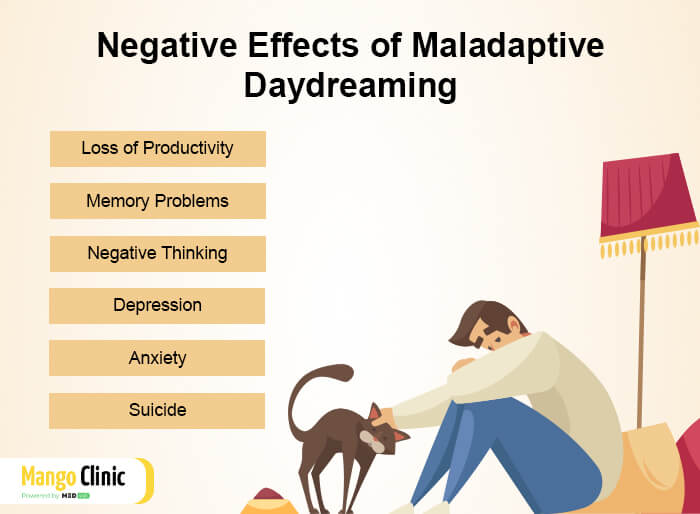
Inability to Focus on Something
Maladaptive daydreaming can make you not focus, especially when it comes to crucial matters. Most patients suffering from maladaptive daydreaming cannot easily connect with their real-life or real world. Also, they cannot build concentration on their usual work tasks, daily chores, or general goals. Their inability to focus can alter their lives and make them less productive than other normal people. Their lack of focus may come along with other complications and struggles such as:
- Overactivity
- Impulsiveness
- Inattention
- Insomnia
Inability to Be Productive
Daydreaming for too long can negatively affect productivity in your daily life. This is because daydreaming for prolonged durations may make you lag on your obligatory tasks and duties. It may also lead to failure in meeting important deadlines, missing on your academic learning, not finishing your basic household chores, and not completing office tasks. Mostly, maladaptive daydreaming can make you spend endless hours lying in bed without getting out to perform your daily duties. Maladaptive daydreaming can as well make you spend many hours in your room while isolating yourself from the rest. This type of isolation gives you room to daydream peacefully without any disturbance and this can negatively affect how you perform certain tasks.
Inability to Sustain Relationships
Maladaptive daydreaming can also affect how you relate with other people including your loved ones. This is attributed to the fact that relations demand a lot of attention and time. When you are struggling with maladaptive daydreaming, sustaining or keeping up with all expectations that come with relationships can be a real problem. Your daydreaming takes out most of your time since you are always immersed in your own imaginary world. In extreme cases, your maladaptive daydream problem may not allow you to snap out of your precarious situation no matter how much your relationship deteriorates. This condition can push you to the limit, not to mention causing you to make abnormal facial expressions and movements. Those around you may not understand your strange behavior. Some may go the extra mile to accuse you of trying to avoid them or not paying attention to them. Your condition may eventually lead to misunderstanding and relationship crises.
Low-quality sleep can lead to mental health issues. Click the button below to book your appointment.
Mental Health Issues (Stress)
Stress and general mental issues are some of the negative aspects of maladaptive daydreaming. This condition is responsible for causing many mental health problems among different people. It may lead to issues such as:
- Anxiety
- Anger
- Hopelessness
- Depression
Maladaptive daydreaming is also known to make patients get captivated with their compulsive fantasies. Some of these fantasies are believed to make individuals with maladaptive daydreaming isolate themselves from everyone in addition to causing them to lose many relations. This is how far maladaptive daydreaming can get you if drastic measures are not taken into consideration. Its impact is very harmful since it can make you feel that you are gradually losing your self-esteem and self-worth.
Insomnia and Sleeping Problems
A study on maladaptive daydreaming concluded that when this condition remains untreated for too long it can cause insomnia and sleep disturbances. Those suffering from this mental condition are usually associated with complex fantasies and elaborate daydreams. Their minds wander into their intrusive and vivid thoughts. If this condition persists without proper care, it can dramatically delay latent periods of sleep. Thus, the affected individuals can have disturbed sleep cycles. This is due to the compulsion of their daydreaming getting longer and longer as the condition persists. Eventually, the affected patients will start to struggle to achieve peaceful and fulfilling sleep. They may also experience low-quality sleep including the inability to fall asleep, especially during the night hours.
How Is Maladaptive Daydreaming Diagnosed?
To date, experts have not yet figured out how they can effectively diagnose maladaptive daydreaming. Again, this mental condition has not been acknowledged or considered a medical diagnosis. For that reason, maladaptive daydreaming has not been categorized under the DSM. This makes it open to additional research. Despite shortcomings associated with the diagnosis of maladaptive daydreaming, experts have been able to come up with all sorts of helpful tools to handle this condition. Bear in mind that you cannot diagnose and even evaluate your maladaptive daydreaming. Only qualified and experienced mental health professionals should be left to perform this important task. Health experts can determine your mental state before making a final diagnosis. That being said, the most effective and efficient tool for determining your mental health is nothing else apart from the signs and symptoms you present. Make sure to be transparent and genuine when providing your mental health history. Accurate information about your history will certainly help your physician come up with the best diagnosis in order to devise the most effective treatment plan. Following methods can help to diagnose maladaptive daydreaming:
Maladaptive Daydreaming Scale
Most mental health conditions can be determined with the help of the MDS-16 scale. Although this is an official test/ scale created by Professor Eli Sommer and his friends, it can help mental health experts diagnose maladaptive daydreaming and any other dissociative disorder. The MDS-16 case is usually based on several factors that come in a set of 16 questions. These factors are as follows:
- Effects of daydreaming on your daily life
- Whether you listen to music while daydreaming or not
- Effects of interruptions while daydreaming
- The overall impact of being unable to daydream
- Common triggers of your daydreaming
- Physical signs/ symptoms and complications that come with daydreaming
The overall score for this test can range from 0 to 100%.
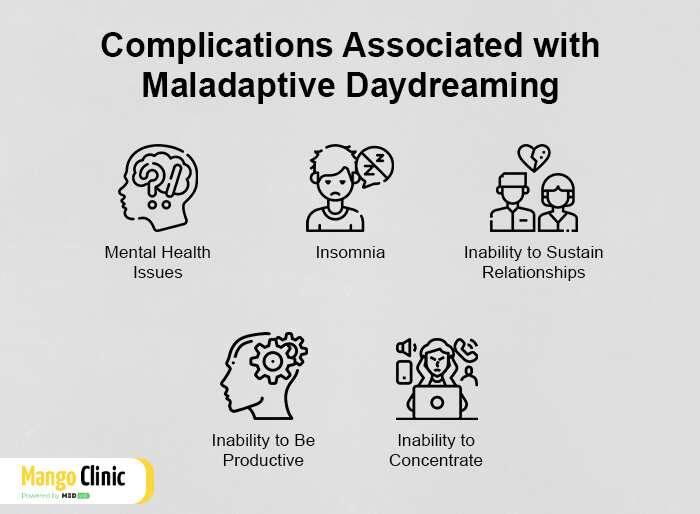
SCIMD (The Structural Clinical Interview for Maladaptive Daydreaming)
SCIMD is yet another unofficial tool used in diagnosing mental health conditions like maladaptive daydreaming. This tool was created by a professor known as Somer. The tool is simply a clinical interview that provides transparency between your therapist and you. It works by looking for answers to your maladaptive daydreaming pattern, behavior, signs, and symptoms. All these indicators can enable your therapist to determine whether you have the maladaptive daydreaming condition or not. Your physician may also use other tools to diagnose your maladaptive daydreaming behavior and thoughts. At the same time, your mental health expert may ask you some questions based on a diagnostic criterion derived from different clinically-proven mental health disorders. The answers you will provide for these questions will undoubtedly help determine your maladaptive daydreaming condition.
Mental health experts at Mango Clinic can help you with maladaptive daydreaming. Click the banner below to book your appointment.
How Is the Maladaptive Daydreaming Test Done?
Check out this self-reporting questionnaire designed to help assess all signs and symptoms of maladaptive daydreaming. The questionnaire can also help you understand whether you are already suffering from maladaptive daydreaming or not. Keep in mind that this is just a questionnaire but not an official mental health diagnostic criterion. The questionnaire does not replace the usual clinical diagnosis by a health professional. Here is the questionnaire:
| I constantly experience an unusual lack of attention and blabbing at work | Never | Sometimes | Mostly |
| I find myself daydreaming for prolonged hours | Never | Sometimes | Mostly |
| I wish my daydream habit could end but I’m always helpless about it | Never | Sometimes | Mostly |
| Daydreaming is negatively impacting my daily life | Never | Sometimes | Mostly |
| Whenever I don’t daydream, I become anxious | Never | Sometimes | Mostly |
| I have not participated in any of my favorite hobbies and recreational activities for quite long | Never | Sometimes | Mostly |
| I love to listen, think, read, or tell stories | Never | Sometimes | Mostly |
| I always suffer from insomnia and other sleeping issues | Never | Sometimes | Mostly |
| I find it difficult to complete tasks at the right time | Never | Sometimes | Mostly |
| I daydream because it makes me feel comfortable | Never | Sometimes | Mostly |
Key Guide
Option A=0 points
Option B=5 points
Option C=10 points
Score
0-20=Normal
21-40=mild
41-60=Moderate
61-100=Severe
Conditions that should be included in your differential diagnosis of Maladaptive daydreaming are psychosis, depression, anxiety disorder, obsessive-compulsive disorder, post-traumatic stress disorder, attention deficit hyperactivity disorder, dissociative disorder, bipolar disorder, and borderline personality disorder. Suicidal behavior is another associated problem that comes with maladaptive daydreaming conditions. According to studies, about 25% of those suffering from maladaptive daydreaming have at one time attempted to kill themselves. The exact connection and cause of these two behavioral problems are yet to be known.
How Do You Stop Maladaptive Daydreaming?
There is still no specific treatment protocol for maladaptive daydreaming. The condition is not yet a recognized clinical diagnosis. Researchers are working tirelessly to figure out exactly what this mental condition is and how it can be treated. Given that maladaptive daydreaming shares several features with other mental health conditions, its treatment option must be similar to that of the symptoms of these other mental disorders. Untreated maladaptive daydreaming can have a negative impact on your life. In extreme cases, this condition can lead you to suicidal thoughts. As such, professional help should remain the ultimate solution to manage your mental health problem. Seeking help from an experienced and knowledgeable health expert should be your priority. Below are a few selected treatment options for maladaptive daydreaming:
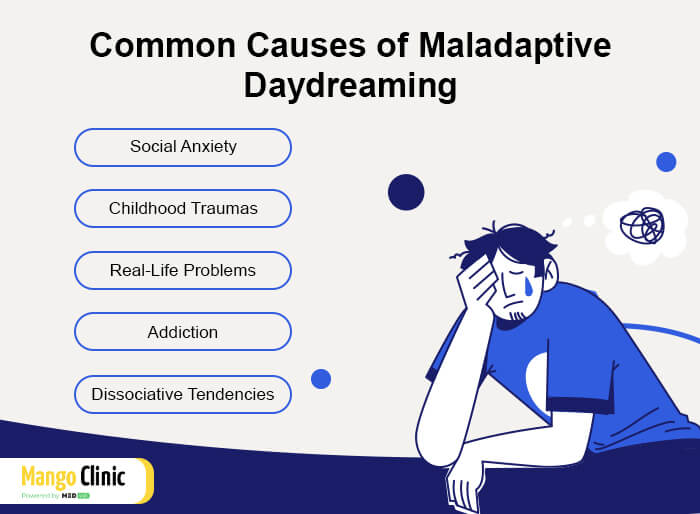
Therapy
This is the most effective way to manage your maladaptive daydreaming problem. Different types of psychotherapies play a critical role in controlling this mental health condition. Examples include:
Cognitive-Behavioral Therapy (CBT)
This is one of the best psychotherapies used in the treatment of mental health disorders. Its main goal is to help you correct all negative thinking patterns, learn coping mechanisms and figure out what triggers the problem. Once a person can control their negative thoughts, recovery becomes faster. For example, a study states that individuals getting cognitive-behavioral therapy managed to reduce their daydreaming behaviors up to 50 percent.
Meditation and Counseling
Both body healing meditation and counseling play an important role in the treatment of maladaptive daydreaming. Their main purpose is to calm your mind and help you achieve concentration in addition to shifting your focus from periods of maladaptive daydreaming. Studies show that meditation and counseling can significantly reduce the intensity or duration of your compulsive daydreaming to around 50%.
Exposure & Response Prevention (ERP)
ERP is another type of therapy that makes you face your fears and worries. It enables you to overcome any compulsive thoughts in addition to neutralizing them. This technique exposes you to similar surroundings so that you can face your fears starting from the smallest going towards the biggest fear. ERP is capable of reducing and stopping your maladaptive daydreaming condition by altering the plots and endings of your thoughts. The technique also makes your thoughts less pleasant.
Maladaptive daydreaming can lead you to depression. Click the button below to book your appointment.
Dialectical Behavior Therapy (DBT)
Dialectical behavior therapy is a modified form of cognitive-behavioral therapy. Its basic idea is to develop resistance against anything that can trigger maladaptive daydreaming. DBT can also help you learn the best coping mechanism. It is a well-known technique that regulates emotions and emotional reactions while helping you to improve your interactions with other people.
Acceptance and Commitment Therapy
This version of therapy enables you to embrace and accept your thoughts. It also helps you free yourself from any form of guilt that can contribute to maladaptive daydreaming. Acceptance and Commitment Therapy is a clinically acclaimed therapy that promotes psychological flexibility, which in turn incorporates mindfulness techniques. With this type of therapy, you can start to commit to your thoughts and even learn how to snap out of your maladaptive daydreaming.
Medication
Sadly, there is still no known official medication protocol to cater to the needs of those with maladaptive daydreaming. Therapies remain largely the most reliable ways to treat this condition. However, some experts believe that fluvoxamine drugs can help those struggling with this mental health condition. The same medication is used widely to treat obsessive-compulsive disorder. Fluvoxamine is part of selective serotonin reuptake inhibitors (SSRI) drugs.
Self-Help Tips and Management Options
Often, mental conditions that don’t have standard medication or treatment protocol are always assumed. If left untreated, these conditions can lead to more destructive behaviors and serious complications in life. Available self-help tips can greatly help manage and even cope with symptoms of your maladaptive daydreaming. Here are the tips to consider:
Increase the quality of rest – Increasing the quality of rest and decreasing fatigue is a helpful way to manage the symptoms of maladaptive daydreaming. You can try the following tips:
- Increase the number of hours of sleep gradually
- Maintain a strict bedtime routine
- Switch off all the devices
- Take care of your sleep hygiene
Learn your symptoms – Knowing your signs and acknowledging them helps you deal with them thoughtfully. When you know your symptoms, you notice how your behaviors and thoughts shift upon external stimuli and triggers. Knowing your signs gives you an opportunity to control and shift your focus from vivid thoughts to the real world.
Reduce fatigue throughout the day – Don’t tire yourself with extra burdens of work throughout the day. Take reciprocal rest periods. An excellent way to relax your mind is by consuming a cup of coffee or tea to boost your mind and calm it. Schedule your last coffee cup to around 6 hours before bed; research suggests that this can help calm your mind without disturbing your sleep cycle. Another idea is to play slow, charming audios to calm yourself. You can also take a walk in the sunshine and spend time in nature and fresh air to soothe your mind and instill positivity from nature.
Get peer support – Your family and friends can be of great help. Share your symptoms and struggles with people you can trust. Sharing will help low down a lot of stress, and together you can create more ways to cope with the symptoms.
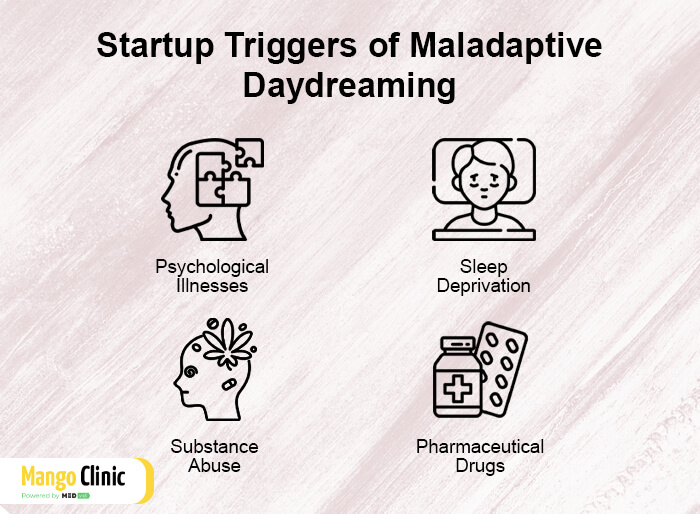
Practice mindfulness – Mindfulness is a great technique to control intrusive thoughts and build concentration on better things. You can start by practicing breathing exercises. All you have to do is:
- Breath in profoundly (inhale)
- Hold your breath for l10 seconds)
- Breathe out deeply (exhale)
- Progress with shifting your entire focus on your body movements as you breathe in and out
- Achieve longer durations of building concentration on a single point of focus while repeating your breathing cycle
Reduce your screen time – You will have to decrease your hours spent on TV, online, gaming, social media, mobile phones, and other gadgets. The more time you spend on screen, the more likely triggers and addictive behaviors will grow. Decreasing screen time will also give you more time to rest and gradually improve your sleep.
Improve your quality of life – This is the last yet crucial coping way for your daydreaming. All that you do and eat in a day affects your mind, body, and overall life. Eat healthy food, stay away from substance abuse and alcoholic beverages. Abstain from processed food and artificial ingredients. Meditate and exercise for at least 30 minutes a day. Indulge into self-care routines such as pampering yourself at a spa etc.
Conclusion
People with maladaptive daydreaming have difficulties functioning normally. Their compulsive thoughts and imaginations become intense and rigid to the extent of not snapping out of them. To date, there is no known standard medication or treatment protocol for maladaptive daydreaming. In addition, this condition is not listed in the Diagnostic and Statistical Manual of Mental Disorders (DSM-5). Fortunately, self-coping and therapy tips have proven to be effective in the treatment of symptoms related to maladaptive daydreaming. Therefore, you should never allow your maladaptive daydreaming condition to stay untreated for too long since it could lead to destructive behaviors and severe complications.
Contact us at Mango Clinic for maladaptive daydreaming treatment or click the banner below to book your appointment.









